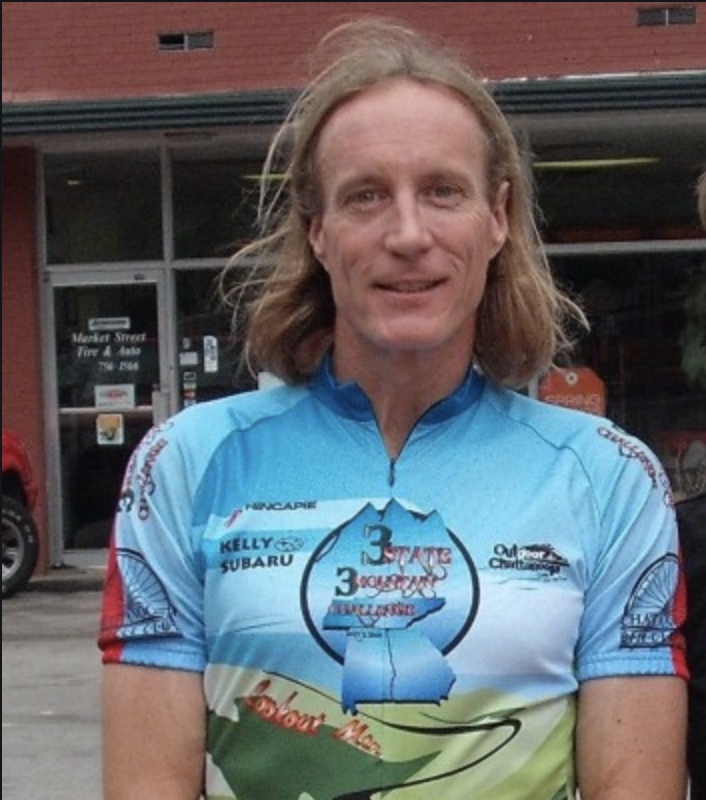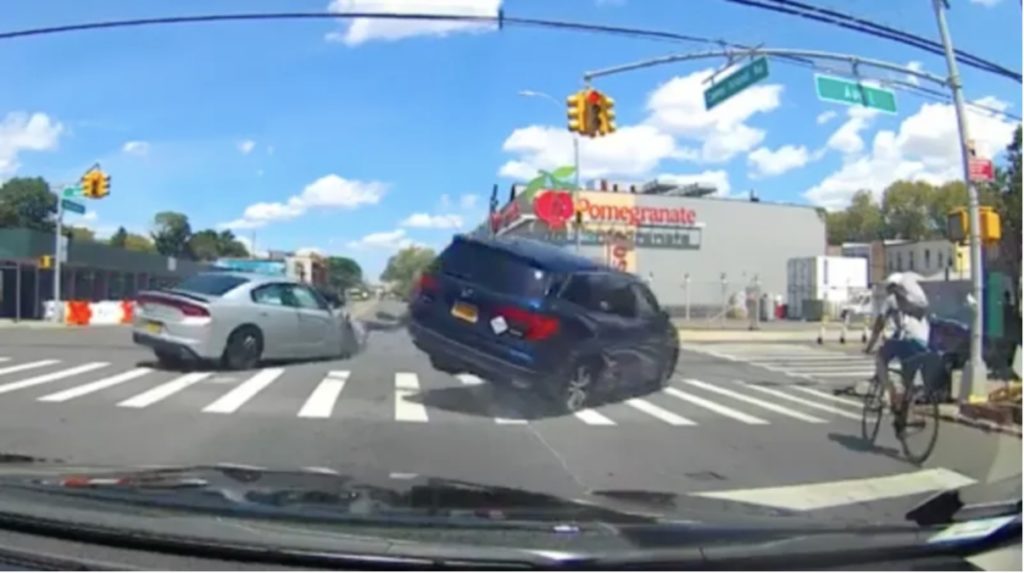
Portland, Oregon- Brett Jarolimek, 31, worked at a local bike shop, and was well-known in the Portland cyclocross scene. On the morning of October 22, 2007, Jarolimek was riding his bike to work. As he passed a garbage truck that had stopped to make a right turn, the truck driver turned across his path, despite Oregon law requiring the truck driver to yield the right of way. It was a classic “bait and hook”—the driver seemed to be yielding the right of way by stopping and signaling, but instead unexpectedly right-hooked the cyclist at the last moment. Jarolimek, who was wearing his helmet, died at the scene.

Chattanooga, Tennessee- David Meek, 51, a custom bicycle frame maker, “did it right,” his widow noted. David’s friends noted that he was “lit up like a Christmas tree” when he rode at night. But the truck driver who “never saw him” passed so close to Meek that his bike bag caught on the truck and dragged him under the tires. Meek, who was killed the morning of March 5, 2009, was wearing a helmet. Despite violating Tennessee’s 3 foot passing law, the driver was never charged.

San Francisco, California- Amelie LeMoullac, 24, worked for a San Francisco public relations firm. On the morning of August 14, 2013, Le Moullac was riding to work when a truck driver made a right turn across her path. Le Moullac, who was wearing her helmet, died at the scene.
In the immediate aftermath of the crash, San Francisco police blamed Le Moullac for the collision, and announced that there was no video of the collision and that no charges would be filed, even though the investigation was still underway. A San Francisco police sergeant even belligerently confronted mourners at her vigil, blocking the bike lane with his cruiser and refusing to end his tirade unless mourners would “admit” that Le Moullac was at fault in the collision.
However, a 10-minute investigation by a San Francisco Bicycle Coalition employee uncovered video evidence that the police said did not exist. This video evidence proved that the truck driver had violated the law when he turned across Le Moullac’s path. Despite this evidence, the District Attorney refused to prosecute the driver.

Los Angeles, California- Milt Olin, 65, was a successful Los Angeles entertainment attorney, with a client roster that read like a Who’s Who of the entertainment industry. Olin was also an avid cyclist. But while out on a ride in the afternoon of December 8, 2013, Olin inexplicably swerved into the path of a Sheriff’s Deputy who “never saw him.” Olin was thrown against the Deputy’s windshield at 48 MPH, shattering the windshield. Olin, who was wearing a helmet, was killed on impact.
Except the Deputy’s account of the collision is not what happened. Witnesses stepped forward and said that contrary to what the Deputy had said, Olin had been riding in the bike lane when the Deputy’s car drifted into the lane, hitting Olin from behind. The Deputy was right about one point, however—he never saw Olin, because he was typing on his mobile computer when he hit Olin. The Sheriff’s Department recommended that criminal charges be filed, but the District Attorney declined to prosecute the Deputy.

New York, New York- Jose Alzorriz, 52, was adamant about safe bicycling. Several of his friends had been injured while riding, so Alzorriz was always reminding people to wear a helmet, stay in the bike lane, and obey the law. His girlfriend recalled that when he found out that she and her daughter didn’t own bike helmets, he bought helmets for them: ““He bought us helmets right away and said, ‘You’re biking in the city. That’s atrocious. You need to protect yourself.’”
On the afternoon of August 11, 2019, Alzorriz pulled up to a Brooklyn intersection and stopped at the red light. At the same moment, a speeding car in oncoming traffic blew through the red light and t-boned a van, which was sent careening into Alzorriz. The van finally came to a rest with Alzorriz pinned underneath. Bystanders attempted to lift the van off Alzorriz, but efforts to save him were futile. Despite his helmet, Alzorriz suffered severe head injuries in the crash and died at the scene. Alzorriz was the 19th cyclist killed on the streets of New York City this year. The driver has been charged with manslaughter.

Jose Alzorriz moments before impact
It’s been a bloody year for New York cyclists. By early July, 15 cyclists had been killed on New York streets, surpassing the total of 10 New York cyclists killed in all of 2018. In mid-August, Jose Alzorriz became the 19th cyclist to die this year. The total now stands at 27 cyclists dead in New York, and there are still 6 weeks remaining before the year is over.
And nationally, the news isn’t any better. Last month, the National Highway Traffic Safety Administration (“NHTSA”) released a report with starkly mixed results—while total traffic deaths decreased in 2018 by 2.4%, traffic deaths had increased for vulnerable road users. Pedestrian traffic fatalities were up by 3.4%, while cyclist traffic fatalities had increased by a shocking 6.3%.
It’s getting worse out there, and something has to be done.
For the National Transportation Safety Board (“NTSB”), that “something” is a proposed nationwide mandatory bicycle helmet law. They might as well have proposed mandatory band-aids. Proposing nationwide mandatory bicycle helmet laws is what well-meaning people do when they realize something has to be done, but (A) they don’t ride bikes, (B) don’t understand the problem, and/or (C) don’t want to take the necessary steps to solve the problem. So they propose something that seems like they’re addressing the problem, but in reality is just a band-aid slapped on to a spurting artery. They propose mandatory bicycle helmet laws.
This is not a question of whether cyclists should wear helmets or not. I ride. I wear a helmet every time. I’ve had my share of going to the ground in life, and almost every time, I’ve gotten up again.
Almost.
The times I’ve hit my head were different. Very different. I’ve done it twice, and I never want to do it again. I still remember the feeling. It’s not so much a “memory” as it is feeling the awful physical impact all over again. It goes beyond “pain.” Way beyond. It rocks you (in a bad way) like you’ve never been rocked before. Trust me on this—if you’ve never hit your head hard on pavement, you don’t want to. Ever.
So I wear a helmet, on the theory that if I do hit my head on pavement, I’d rather have that inch of Styrofoam between my head and the pavement. But I’m also under no illusions about what the helmet can do for me. Helmets are not Magic Styrofoam Hats. They’re just a piece of Styrofoam with a plastic shell. And they’re only designed to withstand the impact from a drop of between one and two meters at 14 MPH—the kind of low-speed impact you’d have if you fell off your bike while stopped at the light, or while riding at low speed on a trail. What helmets are not designed to do is protect a cyclist’s head in high-speed impacts, and in case this isn’t obvious to non-cyclists, helmets are not designed to protect the cyclist’s body at any speed.
So when Brett Jarolimek and Amelie Le Moullac were right-hooked by trucks, their helmets could not protect them from the fatal injuries that ended their lives. And when David Meek was dragged under the wheels of a truck that passed too close, his helmet could not protect him from the fatal injuries he suffered. And when Milt Olin was hit from behind at 48 MPH and thrown against the windshield, his helmet could not protect him from the blunt-force trauma injuries that took his life. And when Jose Alzorriz was pinned under a van that hit after careening through an intersection, his helmet could not protect him from the severe head injuries he suffered.
In each of these instances, the cyclist was wearing a helmet and the helmet did not save the cyclist’s life. And the reason is simple—the helmet can’t protect a cyclist in high-speed impacts with a car, and the helmet can’t protect the cyclist’s body. They’re not designed for that. It gets worse. A newly published study that analyzes data from Australia, New Zealand, the United States, Canada, and the United Kingdom concludes that helmets appear to worsen the risk for traffic crashes and injuries.
Of course, even before this study was published there have been competing claims regarding helmets, with helmet advocates arguing that the available data supports helmet use, while opponents reach the opposite conclusion. Whether the latest study will shift the debate remains to be seen, but each cyclist who wants to understand the debate should read the studies and read the arguments and counter-arguments and decide for themselves.
The bottom line is that whether helmets do more good than harm, or more harm than good, a bicycle helmet is not designed to protect the cyclist in a car-on-bike crash at traffic speeds. At the end of the day, that helmet really is just a piece of Styrofoam with a plastic shell. And some people think that makes it a Magic Styrofoam Hat that miraculously wards off all injuries. Do I wear a helmet when I ride? Yes, always. Do I hope it works if I need it? Yes, absolutely. Do I believe that it will protect me if I’m hit by a car? That’s a more complicated question: I know it can’t protect me in a traffic-speed impact, but I still feel that I’d rather have that Styrofoam between my head and the pavement than not.
But that’s my personal choice, and if the studies warrant a re-think of my choice, I may change my mind. And I have that ability and freedom to read the arguments and counter-arguments and make up my own mind about helmets precisely because we don’t have mandatory helmet laws.
So let’s talk about mandatory helmet laws. The majority of cycling crashes—59% of all cycling crashes—are solo falls. And the vast majority of cyclists in these solo falls are children. Why? Because they’re children learning how to ride a bike. So of course we see large numbers of solo falls with children.
But has there been an alarming increase in low-speed falls resulting in fatal head injuries?
No. but there has been a 6.3% increase in cyclist traffic fatalities. So what problem are nationwide mandatory bicycle helmet laws intended to address? Children (and adults) falling off their bikes? Or cyclists getting hit by cars?
If the mandatory bicycle law proposal is supposed to address children falling off their bikes, the good news is we already have mandatory helmet laws for children in many states. But the NTSB proposal isn’t to enact nationwide mandatory helmet laws for children. The proposal applies to cyclists of all ages.
Let’s get real here. The fact is that nationwide mandatory bicycle helmet laws aren’t being proposed to protect cyclists from falling off their bikes. The proposal is a response to the alarming increase in traffic fatalities, and that is what it needs to be judged by. Cyclists are dying in traffic; will mandatory helmet laws save them from the drivers who are taking their lives?




